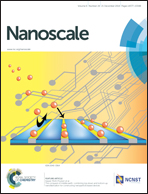The conquest of middle-earth: combining top-down and bottom-up nanofabrication for constructing nanoparticle based devices†
Abstract
The development of top-down nanofabrication techniques has opened many possibilities for the design and realization of complex devices based on single molecule phenomena such as e.g. single molecule electronic devices. These impressive achievements have been complemented by the fundamental understanding of self-assembly phenomena, leading to bottom-up strategies to obtain hybrid nanomaterials that can be used as building blocks for more complex structures. In this feature article we highlight some relevant published work as well as present new experimental results, illustrating the versatility of self-assembly methods combined with top-down fabrication techniques for solving relevant challenges in modern nanotechnology. We present recent developments on the use of hierarchical self-assembly methods to bridge the gap between sub-nanometer and micrometer length scales. By the use of non-covalent self-assembly methods, we show that we are able to control the positioning of nanoparticles on surfaces, and to address the deterministic assembly of nano-devices with potential applications in plasmonic sensing and single-molecule electronics experiments.



 Please wait while we load your content...
Please wait while we load your content...